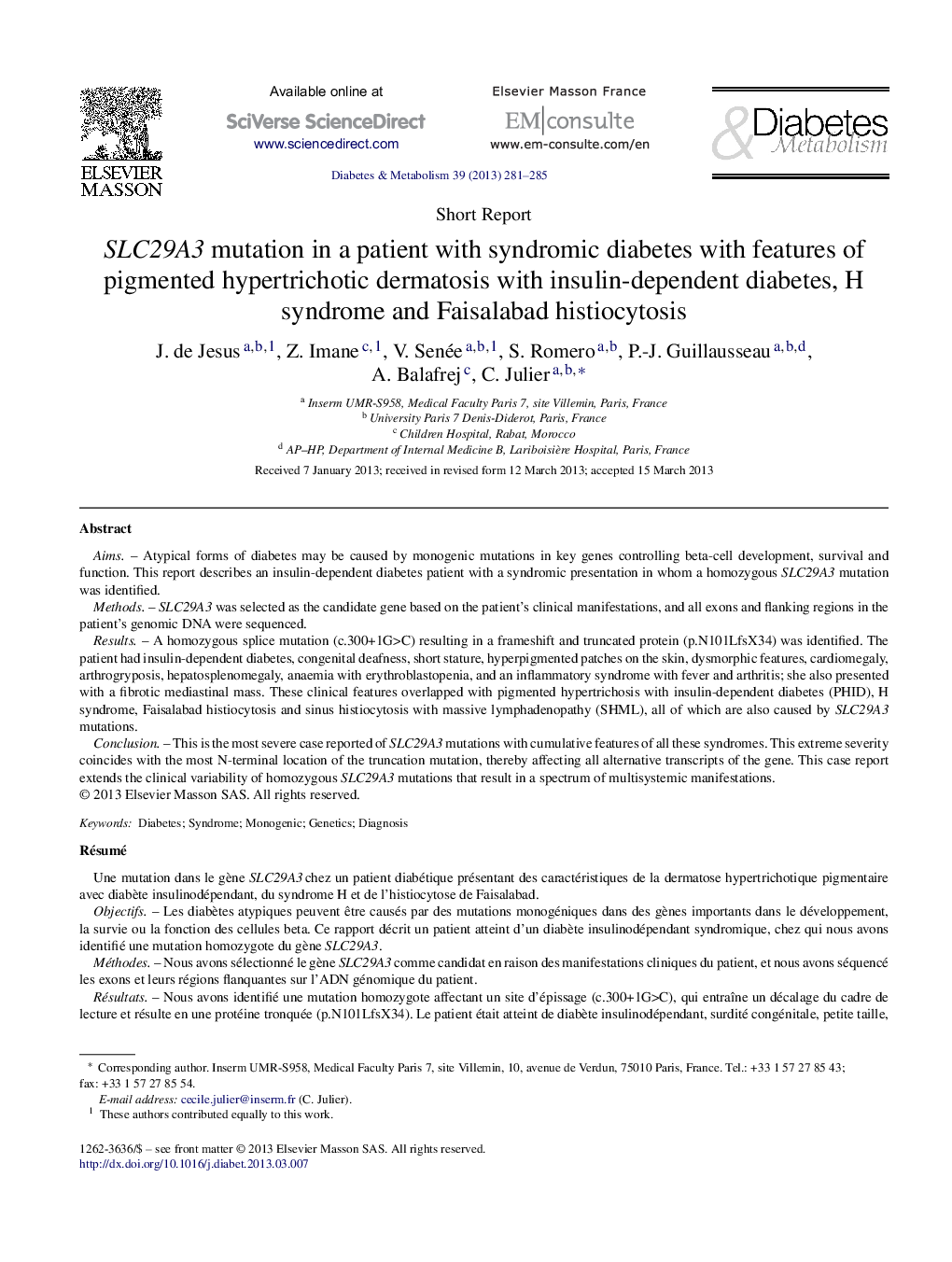| کد مقاله | کد نشریه | سال انتشار | مقاله انگلیسی | نسخه تمام متن |
|---|---|---|---|---|
| 3259887 | 1207593 | 2013 | 5 صفحه PDF | دانلود رایگان |

AimsAtypical forms of diabetes may be caused by monogenic mutations in key genes controlling beta-cell development, survival and function. This report describes an insulin-dependent diabetes patient with a syndromic presentation in whom a homozygous SLC29A3 mutation was identified.MethodsSLC29A3 was selected as the candidate gene based on the patient's clinical manifestations, and all exons and flanking regions in the patient's genomic DNA were sequenced.ResultsA homozygous splice mutation (c.300+1G>C) resulting in a frameshift and truncated protein (p.N101LfsX34) was identified. The patient had insulin-dependent diabetes, congenital deafness, short stature, hyperpigmented patches on the skin, dysmorphic features, cardiomegaly, arthrogryposis, hepatosplenomegaly, anaemia with erythroblastopenia, and an inflammatory syndrome with fever and arthritis; she also presented with a fibrotic mediastinal mass. These clinical features overlapped with pigmented hypertrichosis with insulin-dependent diabetes (PHID), H syndrome, Faisalabad histiocytosis and sinus histiocytosis with massive lymphadenopathy (SHML), all of which are also caused by SLC29A3 mutations.ConclusionThis is the most severe case reported of SLC29A3 mutations with cumulative features of all these syndromes. This extreme severity coincides with the most N-terminal location of the truncation mutation, thereby affecting all alternative transcripts of the gene. This case report extends the clinical variability of homozygous SLC29A3 mutations that result in a spectrum of multisystemic manifestations.
RésuméUne mutation dans le gène SLC29A3 chez un patient diabétique présentant des caractéristiques de la dermatose hypertrichotique pigmentaire avec diabète insulinodépendant, du syndrome H et de l’histiocytose de Faisalabad.ObjectifsLes diabètes atypiques peuvent être causés par des mutations monogéniques dans des gènes importants dans le développement, la survie ou la fonction des cellules beta. Ce rapport décrit un patient atteint d’un diabète insulinodépendant syndromique, chez qui nous avons identifié une mutation homozygote du gène SLC29A3.MéthodesNous avons sélectionné le gène SLC29A3 comme candidat en raison des manifestations cliniques du patient, et nous avons séquencé les exons et leurs régions flanquantes sur l’ADN génomique du patient.RésultatsNous avons identifié une mutation homozygote affectant un site d’épissage (c.300+1G>C), qui entraîne un décalage du cadre de lecture et résulte en une protéine tronquée (p.N101LfsX34). Le patient était atteint de diabète insulinodépendant, surdité congénitale, petite taille, tâches pigmentaires sur la peau, dysmorphies, hépatosplénomégalie, cardiomégalie, arthrogrypose, anémie avec érythroblastopénie, syndrome inflammatoire avec fièvre et arthrite, et présentait une masse fibrotique médiastinale. Ces caractéristiques cliniques présentent des similitudes avec la dermatose hypertrichotique pigmentaire avec diabète insulinodépendant, le syndrome H, l’histiocytose de Faisalabad et l’histiocytose du sinus avec lymphadénopathie massive, qui sont causés par des mutations du gène SLC29A3.ConclusionIl s’agit du cas le plus grave de patient porteur de mutation SLC29A3, qui cumule les caractéristiques de ces syndromes, ce qui coïncide avec la position N-terminale de la mutation de troncation, qui concerne tous les transcrits alternatifs du gène. Notre observation élargit la variabilité clinique des mutations homozygotes SLC29A3, qui résultent en un spectre étendu de manifestations multi-organes.
Journal: Diabetes & Metabolism - Volume 39, Issue 3, May 2013, Pages 281–285